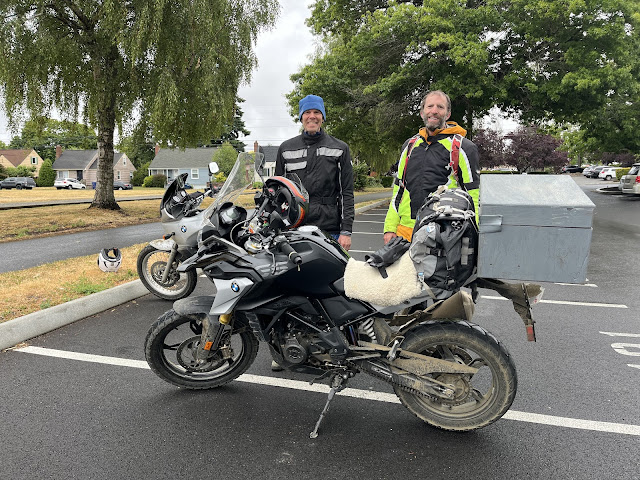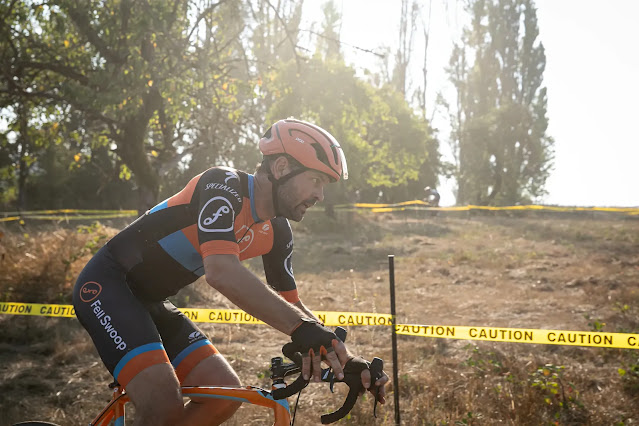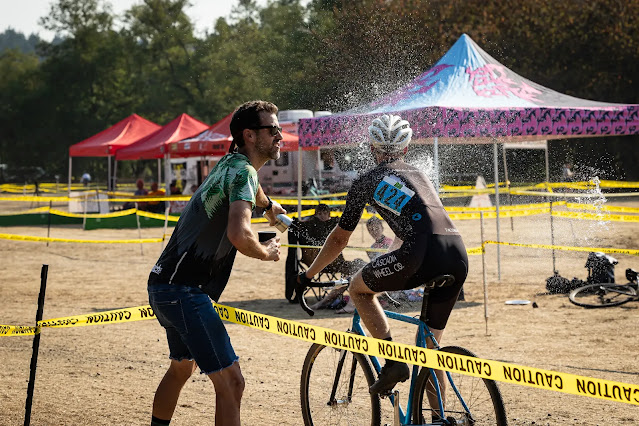Circumnavigating the Olympic Peninsula isn't that exciting. Doing it aboard motorcycles ups the fun a bit. My friend Dave proposed a route that added even more fun by using as many dirt roads and other out of the way roads as possible. I jumped at the chance to join him. We landed on a plan for a four day three night adventure.
Day one was short. We started on a warm Wednesday afternoon and had a goal of just 70 miles. We started in Tacoma, crossed the Narrows, and headed North through Manchester and then Port Orchard. I was familiar with many of these roads as they are great cycling roads. After getting through Bremerton we again entered familiar territory as I grew up near Silverdale and Poulsbo. We arrived at our campsite without drama after just over two hours of riding. I did, however, learn that my new helmet was not fitting all that well and more frequent stops might be necessary.
Dave is a well seasoned bikepacker and backpacker. Me, not so much. But the early indications looked positive. After one night I encountered no serious issues with my camping gear or tent assembly skills.
 | |
Our plan included a trip up Hurricane Ridge. But it was not to be. Thursday happened to be a federal holiday and the Park was offering one of its 'no fee' days. There was a two hour wait to enter the park. That didn't appeal to Dave or me. So I offered an alternative. "Let's have lunch at Chipolte, instead!" So Port Angeles wasn't a total bust.
After lunch the weather remained dry but felt cooler. I added a layer as the next sector was going to be mostly 50 mph pavement as we headed towards Neah Bay.

We skipped Highway 101 and opted for the slower and more twisty alternative through Joyce. This road was fun despite the extra weight of the gear piled onto our motorcycles. We arrived at Neah Bay about 4 p.m. We didn't have a reservation at the campground but there was still plenty of space. We found a little corner of the campground that was slightly raised and separated by a few low bushes. Our motorcycles were happy to sneak past the bushes and it felt like we were in the best camp site. The sun was out, it was warm, and the wind was low. Perfect.
We set our tents quickly and then took an excursion out to the Cape Flattery trail. It was my first time to Cape Flattery. The sign claims the trail takes 25 minutes. I made the bold claim that two guys who have the fitness to race bicycles competitively could beat that average by at least three minutes.
No timer was set but we reached the first viewpoint quick enough. The view was mesmerizing with cliffs, waves, trees, and the blue ocean all bathed in afternoon sunlight. And each viewpoint was more awe inspiring than the previous. We took our time, snapped some photos, and slowly moved our way along the trail.
 |
| This is a photo of Dave. When I asked him to pose he asked "Will I be in silhouette with the strong backlight?". I responded, "Sorry Dave, this photo isn't about you..." |
As we approached the final viewing platform we noticed a small viewing area to the side of the trail. A couple stood alone in this area. Just as we arrived the man took a knee and proposed to the woman. She started to tear up. There were only three of us that witnessed the actual proposal but within a minute or two the story got around to all the visitors in the area and everyone let them have their space. So cool.
Once back at camp we cooked dinner and then took a walk on the ocean beach. The weather remained warm and the winds light. This day simply couldn't last long enough.

Our schedule for day three started easy. We slept in, took our time making breakfast and packing up, and didn't get underway till almost ten. We planned a trip through the Makah museum which didn't open until ten. The story told in the museum wasn't on my radar. In short, about 500 years ago a mudslide buried a village in Ozette. The mud preserved most of the village. The artifacts were recovered over the course of about 3 year in the mid 1970s. The displays were fantastic with actual artifacts next to modern reproductions and descriptions of the construction and use of the artifacts. I highly recommend this museum.
The weather forecast for day three wasn't good. We expected intermittent rain after about noon. We didn't make it but 15 minutes out of Neah Bay before Dave declared it was time for rain gear. On day one I might have been a little concerned about my camping gear. On day three I was very concerned about my rain gear. I don't own proper motorcycling rain gear so I improvised by wearing a hiking rain jacket under my motorcycle jacket. For the legs I went with an old pair of oversize stowable hiking pants over my riding pants.
An hour later we took a short break in Forks for a snack. On the way out of Forks the skies let loose. Within minutes I was soaked below the waist. My top half stayed completely dry the entire day. Fifty percent success ain't too bad, right?
In the neighborhood of Kalaloch the sun came back out and the air warmed considerably. Dave made an in-the-moment decision to follow a sign to 'Big Ceder Nature Trail'. We needed a break from riding and he liked the idea of walking a trail while the sun was out. I approved. The trail was short and we did see a number of big cedar trees. We also found a few ripe salmon berries. Mostly we enjoyed a few minutes in the sun, on our feet, and off the buzzing bikes.
We decided on a late lunch in Quinalt. And we needed it. The weather turned on us again and we were feeling a bit low.
The 'Mercantile' store was a bust. Chips and crappy sandwiches in plastic boxes. That didn't work. Across the street was the Quinalt Lodge and it's fancy-schmancy restaurant.
We stepped inside the lodge. We were dressed in wet and almost dripping motorcycle gear. We felt bedraggled. We looked bedraggled. The restaurant was closed. A woman near us could sense our dilemma and shared that the bar was taking food orders. Sweet. Dave and I ordered fish tacos. Just as we started our search for a table, a couple got up from their spots sitting on the hearth in front of the giant fireplace. I didn't hesitate and within a minute or two the brick throne was warming our bones and souls.
A few minutes later the woman who advised us on food situation joined us on the hearth. She brought her boyfriend. They asked us about our trip and we gave the thirty second summary. A minute later we discovered they were both from Atlanta which is Dave's home town. The three of them shared so many Atlanta stories. It seems they all knew lots of the same places and attractions. After a long while, out of kindness or pity, someone asked where I was from. Nice.
Our food took forever but we were so happy when it arrived. We spent over an hour in the lodge and it was time well spent. We needed the spiritual recharge as we had miles to go before nightfall.
Before we left the lodge we took a look at the route between us and our planned campground. It was roughly ten miles of pavement and then forty miles of gravel roads.
When planning this trip Dave asked for my input. I was happy to let him make most of the decisions but I was clear on one detail. I didn't want to be arriving late to camp and setting up in the dark. This day was in jeopardy of just such a scenario.
Our previous average speeds on pavement and gravel indicated we would likely make it by 7 p.m. If we failed to make this arbitrary arrival time we were prepared to camp dispersed in the National Forest.
Leaving Quinalt we fueled the bikes for the final time. The bad news. I haven't seen such a high gas price in a long time. The good news. My motorcycle was averaging almost 50 mpg.
 |
| This photo snapped just _after_ the super technical section. Sorry. On such a technical section we couldn't operate both the motos and the cameras. |
The rain started to taper as we knocked off the easy ten miles of pavement. We turned left into the forest and the road turned vicious. It was steep, twisty, rocky, and wet. Easily the most technical section of the entire trip. We rode just three miles and reached the top of the ridge before taking a short break to discuss our situation. These tight roads were hurting our speed average but we hoped for smoother gravel closer to the campground.
And it was so. Over the next ten miles the roads trended less technical and the final ten miles or so of gravel were smooth, straight, and featured occasional sunshine. We arrived at the campground at 7:05. Near perfect.
Day four brought the sound of raindrops on the rainfly of my tent. My previous evening's preparations were spot on. All my gear was out of the weather and I happily stayed in my warm and dry sleeping bag as long as possible. After cooking oatmeal inside Dave's 'Mega Mid' tent we packed our things for our final day.
We endured one more rain shower before stopping in Tacoma for a final 'end of ride' photo.

It was a great trip. I hadn't done a proper motorcycle trip in decades and this was a great way to rekindle that joy. I'm already thinking on a route for the next one.




















